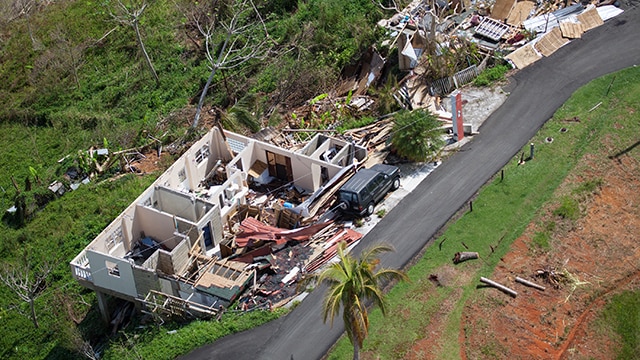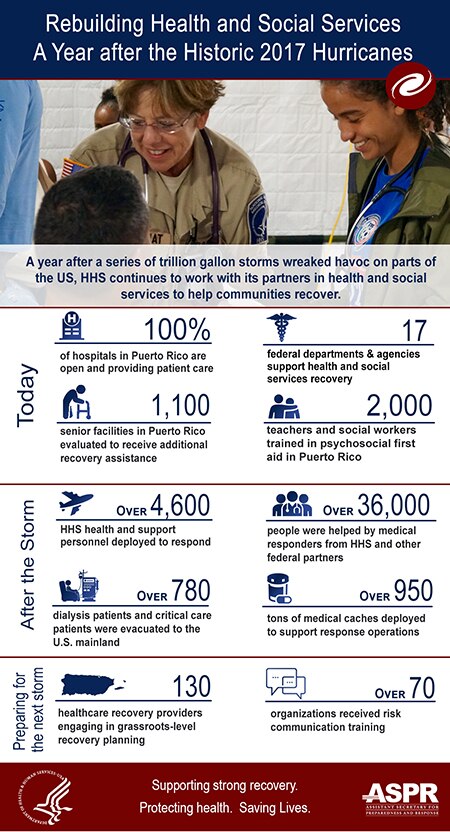September 20, 2018
Summary:
While the Carolinas grapple with the impact of Hurricane Florence, it’s been a year since Maria hammered Puerto Rico and U.S. Virgin Islands.
While residents of the Carolinas grapple with the impacts of Hurricane Florence, it will be important to remember that recovery from disasters is a marathon, not a sprint. It’s been a year since 24.5 trillion gallons of water fell on Texas from Hurricane Harvey. This month, we also reach the one-year mark since Hurricanes Irma and Maria hammered the U.S. Virgin Islands, Puerto Rico and Florida with winds exceeding 155 mph.
In the last year, I’ve spent a lot of time in these places, in communities devastated and gutted by incomprehensible forces of nature. I’ve seen miles of boulevards in coastal Texas where the entire contents of a family’s life – photo albums, clothing, furniture – are piled on the curb. Their ruined belongings waited weeks for a dump truck equipped with a crane to pluck them off the curb and drop them into a bin with everyone else’s.
In the U.S. Virgin Islands, I’ve seen 15-foot-tall chain link fences bent in half and countless homes with tarps for roofs. I’ve had the honor of working with dedicated public servants who continue to press on serving their islands despite minimal staffing.

Hurricane Maria devastation in Puerto Rico, FEMA photo
In Puerto Rico, I’ve seen massive wind mills with shattered blades, concrete power poles broken in three places, and heard the constant hum of generators blended with sounds of the coqui tree frog. I’ve met leaders of elder care facilities who told me stories of using their own bodies to protect their residents while the roof and HVAC system were ripped from a building older than Puerto Rico itself!
Over the past year, the Office of the Assistant Secretary for Preparedness and Response has coordinated with experts from across the department and the federal government as well as health and social service leaders – hospitals, long-term care, dialysis, school leaders, social service providers, emergency managers and local government – in the impacted states and territories to help them walk through how they will respond together this season and in seasons to come. This approach was new for many of them. Our goal was to connect resource needs with resource providers to help each state and territory recover efficiently and effectively. We will work just as diligently to help those impacted by Hurricane Florence and the other disasters to come.
From experience, we know that disaster anniversaries are difficult: Survivors often feel increased stress, anxiety, depression, and can be more susceptible to substance abuse. These times also remind those in the marathon of recovery that it is a complicated and often frustrating process. While national attention fades, the impacted communities must sustain their momentum to recover without fanfare.
Many people are still rebuilding their homes, communities, and lives. Recovery is a long road. Remember to take care of yourself and take advantage of the resources around you including the Disaster Distress Helpline.
Even if you haven’t been in a recent disaster, remember your fellow Americans who have. Get involved. The National Voluntary Organizations Active in Disasters (NVOAD) are a great starting place  . Just as importantly, prepare yourself and your family to be ready for the next disaster and its aftermath. Learn about disaster recovery, too.
. Just as importantly, prepare yourself and your family to be ready for the next disaster and its aftermath. Learn about disaster recovery, too.
I was once asked, “How long do we have to prepare?” The answer is simple: “until the next one.”

https://www.hhs.gov/blog/2018/09/20/a-year-later-still-recovering-from-trillion-gallon-storms.html
No comments:
Post a Comment